Guy's Cliffe
Guy's Cliffe (variously spelled with and without an apostrophe and a final "e") is a hamlet on the River Avon and the Coventry Road between Warwick and Leek Wootton in Warwickshire, England, near Old Milverton.
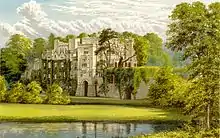
Civil parish
It is in the civil parish of Leek Wootton and Guy's Cliffe; the latter was ecclesiastically on the same boundaries a minor chapelry. The secular version of the unit (i.e. civil parish) was, for a time, the least populous third-tier local authority in England; from 1 April 1986 it was merged with Leek Wootton to become Leek Wootton and Guy's Cliffe civil parish.[1]
The name Guy's Cliffe originates from the name of the country house and estate that the land belonged to, which in turn was named after the cliff which the house itself was built on. The house has been in a ruined state since the late 20th century and is on the Heritage at Risk Register due to significant problems.[2]
History
Before 1900
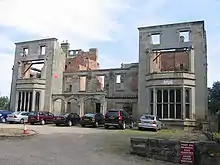
Guy's Cliffe has been around since Saxon times and derives its name from the legendary Guy of Warwick. Guy is supposed to have retired to a hermitage on this site, this legend led to the founding of a chantry. The chantry was established in 1423 as the Chapel of St Mary Magdelene and the rock-carved stables and storehouses still remain. After the Dissolution of the Monasteries by Henry VIII the site passed into private hands.
The current, ruined house dates from 1751 and was started by Samuel Greatheed, a West India slave-owner, merchant and Member of Parliament for Coventry 1747-1761. His son Bertie Greatheed inherited the estate after the death of his mother in 1774, he further improved the house and grounds in 1810, to heighten the picturesque qualities of the site.[3]
The estate also comprised a mill, stables, kitchen garden and land as far as Blacklow Hill.
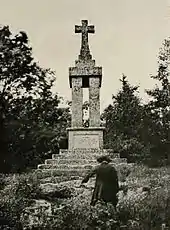
Blacklow Hill is north-west of the house. It is the site of an ancient settlement and the location of Piers Gaveston, 1st Earl of Cornwall's murder.
In 1308 Edward II travelled to Boulogne to marry Isabella, leaving Piers Gaveston, a Gascon knight to act as regent. Resentment against Edward's rule and Gaveston's position of power grew, some barons began to insist Gaveston be banished. Edward could do little to prevent Gaveston being captured in 1312 under the orders of the Earl of Lancaster and his allies. He was captured first by the Earl of Warwick, whom he was seen to have offended, and handed over to two Welshmen. They took him to Blacklow Hill and murdered him; one ran him through the heart with his sword and the other beheaded him..
In 1821 Bertie Greatheed erected a stone cross to mark the execution of Piers Gaveston, "Gaveston's Cross" and later commented in his diary that he could read the inscription on the cross with his telescope from the house.
1900 Onwards
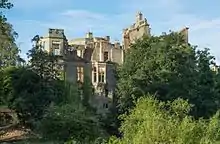
The house was used as a hospital during World War I and in World War II became a school for evacuated children.
Guy's Cliffe estate was broken up and sold in 1947. In 1952 the mill became a pub and restaurant and was named The Saxon Mill, the stables became a riding school, the kitchen garden became a nursery, all of which still exist today. A toll house also stood by the road to the north of the Saxon Mill, but this was demolished in the mid 20th century.
The new owner of the house intended to convert it into a hotel, but these plans came to nothing and the house fell into disrepair. In 1955 the house was purchased by Aldwyn Porter and the chapel leased to the Freemasons, establishing a connection with the Masons that remains today. The roof had fallen in by 1966. In 1992 during the filming of The Adventures of Sherlock Holmes (The Last Vampyre) a fire scene got out of control and seriously damaged the building, leading to an insurance claim. English Heritage has given the building grade II listed status.
One new house was built within the grounds, Guy's Cliffe House (note: the ruined house and by the 1980s, when the parishes merged, the population of the Parish of Guy's Cliffe was no more than 4 people. The new boundary split the original estate: the stables and nursery are not within the current Parish of Leek Wootton & Guy's Cliffe, but the house, mill and modern homes are.
Geology
The cliff is protected as Guy's Cliffe Site of Special Scientific Interest (SSSI) due to its geological interest.[4] Its citation states that this is due to it being a good exposure of Middle Triassic sandstone which is of particular interest for fossils of Mastodonsaurus.[5]
Points of interest
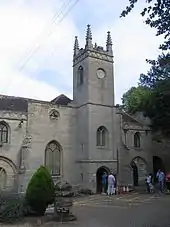
- The chapel, used for Masonic ceremonies, has a large statue depicting Guy of Warwick.
- Piers Gaveston, the favourite of Edward II, sought refuge and was (allegedly) apprehended here before his execution on nearby Blacklow Hill at Leek Wootton.
- Saxon Mill on the River Avon, a former water-powered mill, now a pub and restaurant.
See also
References
- Warwickshire Museum details for Guy's Cliffe House
- English Heritage: Heritage Gateway, architectural description of listed building
- A History of the County of Warwick Vol 8 (1969) pp434-447 British History Online
- Specific
- "Parish and Town Councils Application - Warwickshire Web". apps.warwickshire.gov.uk.
- "HERITAGE AT RISK 2019 / MIDLANDS Register 2019". historicengland.org.uk. Retrieved 9 November 2019.
- "Guy's Cliffe Profile » Historical Image Archive". guyscliffehouse.co.uk. Retrieved 2020-06-27.
- "Guy's Cliffe SSSI". designatedsites.naturalengland.org.uk/. Retrieved 27 September 2020.
- "GUY'S CLIFFE" (PDF). designatedsites.naturalengland.org.uk/. Retrieved 27 September 2020.
External links
![]() Media related to Guy's Cliffe at Wikimedia Commons
Media related to Guy's Cliffe at Wikimedia Commons
- The GuysCliffeHouse.org.uk Photo Gallery Archive » A collection of historical and modern day photographs, images and depictions of Guys Cliffe House, Warwickshire, England...
- Guys Cliffe House entry from The DiCamillo Companion to British & Irish Country Houses
- The Civil Parish of Leek Wootton and Guy's Cliffe Hubsite
- Leek Wootton & Guy's Cliffe Parish Council

